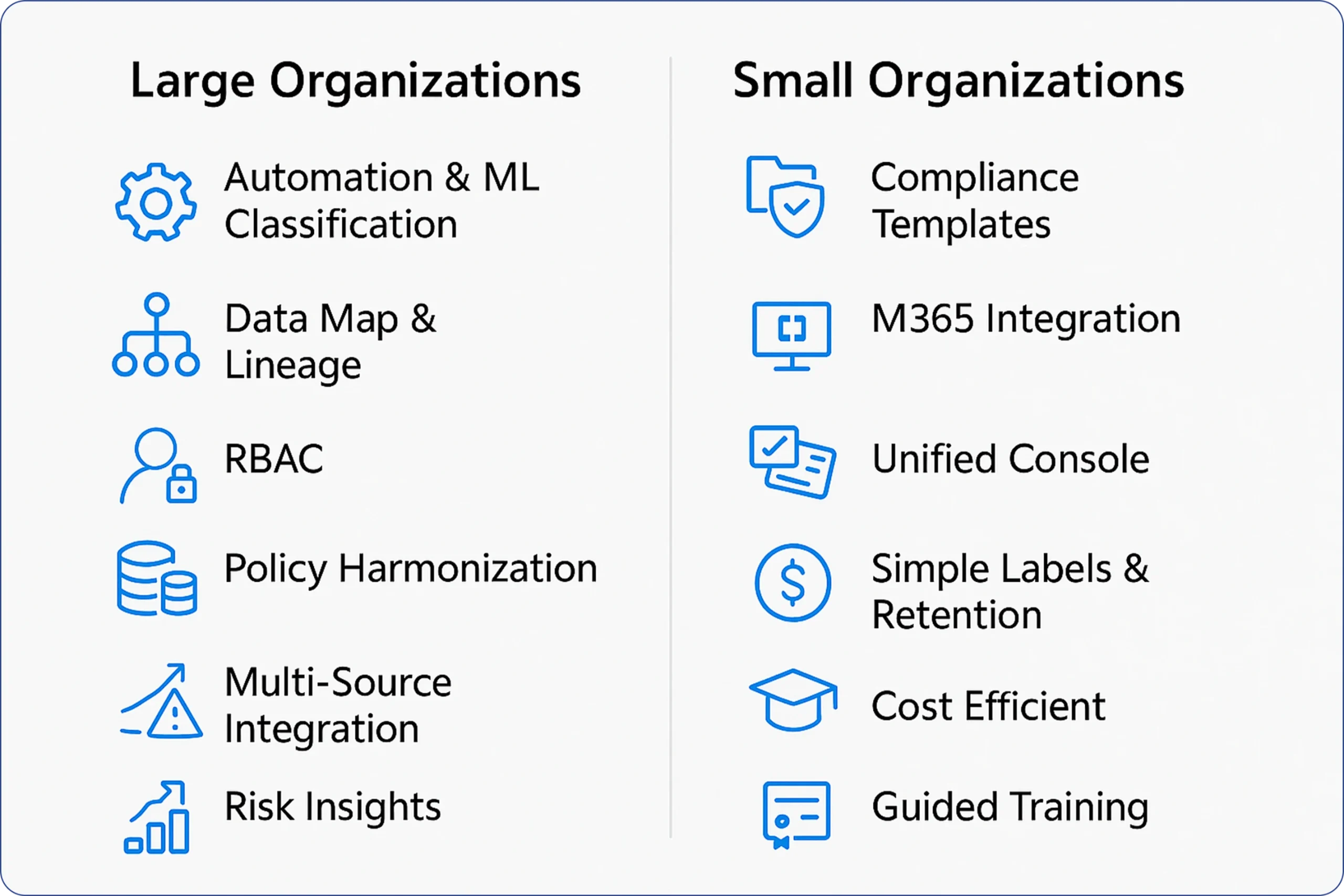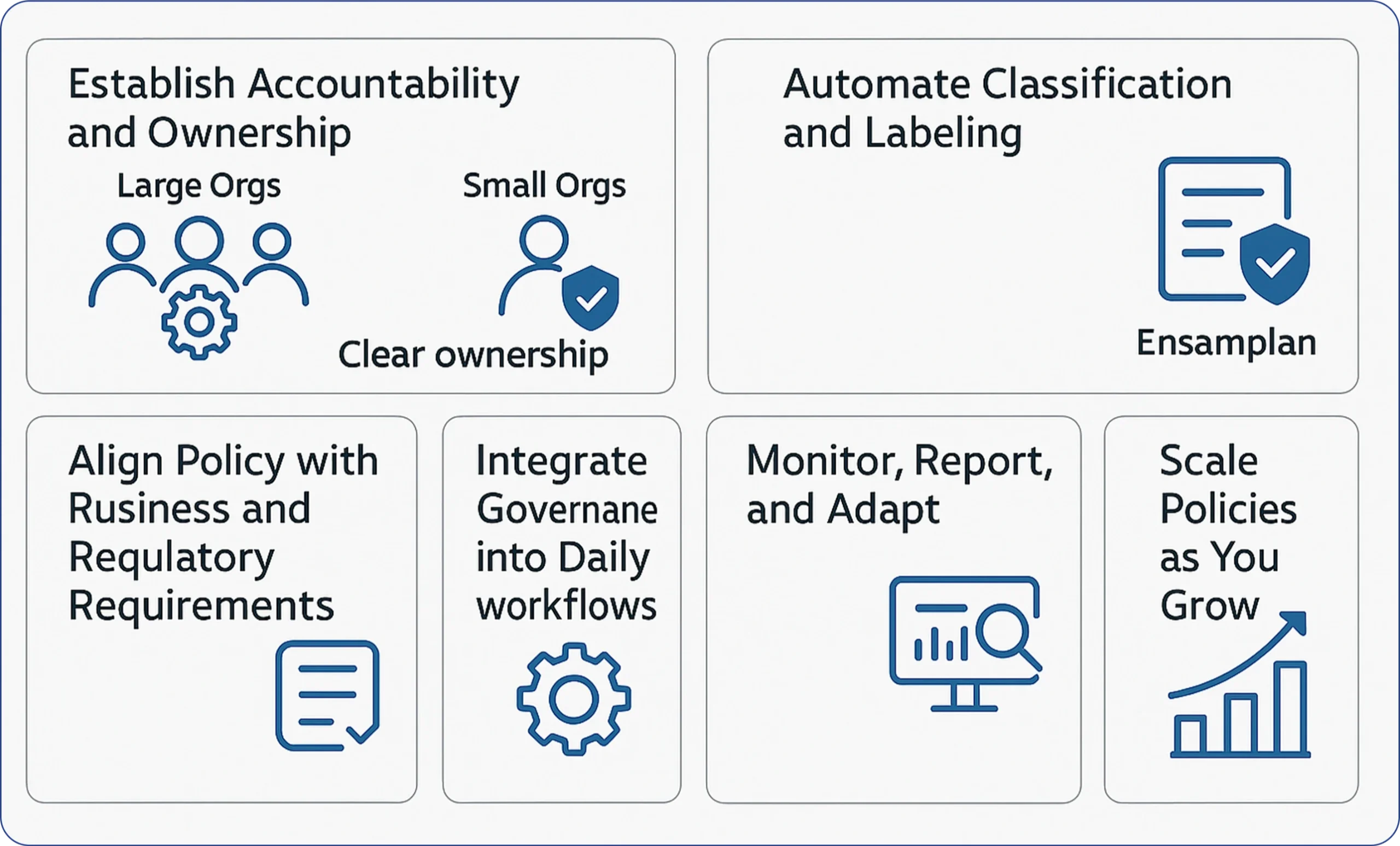Large vs. Small Organizations: The Differences in Information Governance with Microsoft Purview
In today’s data-driven world, information governance is more than just a compliance requirement—it’s a cornerstone of healthy, secure, and efficient organizations. As organizations grow, their approaches to information governance must evolve, ensuring that data usage remains controlled, compliant, and value-generating
Table of Contents
- What is Microsoft Purview
- Understanding Information Governance
- Overview of Microsoft Purview
- Key Governance Challenges for Organizations
- Distinct Needs: Large vs. Small Organizations
- How Microsoft Purview Bridges the Divide
- Case Studies: Real-World Scenarios
- Best Practices for Effective Information Governance with Microsoft Purview
- The Future of Information Governance: Trends to Watch
What is Microsoft Purview
Microsoft Purview, an advanced suite for data governance and compliance, has emerged as one of the most powerful tools for this purpose. However, the paths to leveraging these technologies can differ dramatically between large and small organizations.
This article delves into the core distinctions between large and small organizations regarding information governance, with a special focus on how Microsoft Purview addresses their unique needs. Whether you’re representing a multinational enterprise or a boutique firm, understanding these differences is key to building a resilient governance framework.
Understanding Information Governance
Information governance (IG) refers to the processes, policies, and technologies that manage the use, security, availability, and integrity of data across its lifecycle. Effective governance ensures that information is not only compliant with legislative requirements but also supports operational efficiency, business insights, and value creation.
According to Infotechtion, successful IG encompasses:
- Policy management
- Risk assessment
- Data discovery and classification
- Retention and disposal
- Security and privacy controls

As highlighted in Infotechtion’s approach to Microsoft Purview, integrating these elements is crucial for modern organizations in meeting evolving regulatory and business imperatives.
Overview of Microsoft Purview
Microsoft Purview is a unified data governance solution that helps organizations manage, protect, and utilize their data at scale. Its capabilities include:
- Data discovery and classification
- Risk management and compliance monitoring
- Data lifecycle management (retention and disposal)
- Data mapping and cataloging
- Privacy and access controls
Microsoft Purview’s suite is especially valuable because it integrates natively with Microsoft 365, Azure, and various on-premises and SaaS environments. This makes it an ideal solution for the hybrid work era, enabling governance across multiple data repositories.
Key Governance Challenges for Organizations
While information governance is essential for all businesses, its implementation is rarely straightforward. Key challenges include:
1. Data Volume and Complexity
Large organizations generate petabytes of data across global offices, departments, and cloud environments. Small organizations, while handling less data, often struggle with silos and scattered information due to lack of centralized systems.
2. Regulatory Demands
Industries such as finance, healthcare, and manufacturing face stringent regulations like GDPR, HIPAA, CCPA, and more. Meeting these can be considerably harder as organizations grow, but even startups risk fines for non-compliance.
3. Security Threats
Cyber threats target organizations of all sizes. However, larger companies face more sophisticated attacks (e.g., supply chain, ransomware), while smaller organizations may lack resources for a comprehensive defense or quick recovery.
4. Cultural and Resource Gaps
Large organizations typically possess IT and compliance teams, whereas small companies might assign information governance tasks to one overburdened IT generalist.
Infotechtion’s whitepapers often emphasize that failure in any of these areas can result in lost data, brand damage, and costly regulatory penalties.
Distinct Needs: Large vs. Small Organizations
Let’s break down the distinctive infogovernance requirements and realities faced by enterprises and SMBs:
Large Organizations
1. Scale & Complexity: Large enterprises host data across multiple geographies, business units, and regulatory zones. Their governance frameworks must account for:
- Diverse data sources (SharePoint, Teams, SAP, legacy systems)
- Multi-layered access controls
- Coordinating global retention and classification policies
2. Resource Availability: Large companies usually maintain dedicated compliance, legal, and IT risk teams. They can afford the investments in automation, advanced analytics, and third-party integrations.
3. Strict Regulatory Oversight: Large organizations are more visible targets for audits and legal scrutiny, increasing pressure for tight control over personal, financial, and sensitive information.
4. Legacy System Challenges: Integration of governance tools with a web of legacy IT systems is a persistent hurdle. Digital transformation is typically gradual.
5. Change Management: Driving consistent information governance across subsidiaries, divisions, and cultures can be a massive change management task.
Small Organizations
1. Limited Resources: Smaller firms may lack dedicated compliance personnel. Governance tasks may fall on a single IT manager or outsourced MSP.
2. Simplicity and Flexibility: With fewer departments/locations, small organizations can deploy governance tools quicker and with less organizational resistance.
3. Cost Sensitivity: Budgets are tighter. The ideal governance solution needs to provide robust features with low management overhead, preferably integrated with existing services (like Microsoft 365).
4. Awareness & Training Gaps: With less exposure to regulatory demands, small companies are more prone to accidental breaches due to employee negligence.
5. Business Agility: Small organizations need governance to be agile and scalable as their business (and risk profile) rapidly evolves.
Infotechtion’s blog on IG success highlights how right-sizing governance is just as crucial as implementation.
How Microsoft Purview Bridges the Divide

Microsoft Purview offers a broad array of features that can be tailored to both ends of the organizational spectrum. Here’s how:
For Large Organizations
1. Automation & Advanced Classification Purview automates the classification of vast troves of content using ML-driven sensitive information types, trainable classifiers, and pre-built policies. This is essential for large-scale operations, where manual classification is unfeasible.
2. Data Map and Catalog With features like the Purview Data Map, enterprises can discover, map, and track data lineage across the organization, which helps in:
- Compliance audits
- Identifying data flows between systems
- Enabling data stewards and compliance officers to maintain visibility
3. Role-Based Access Control (RBAC) Granular access controls can be assigned based on region, department, or even individual, reducing insider risks and supporting global compliance efforts.
4. Policy Harmonization Centralized policy management allows global teams to deploy, monitor, and update DLP, retention, and encryption rules enterprise-wide.
5. Integration with Non-Microsoft Data Sources Large businesses often operate diverse IT environments. Purview can connect with AWS, SAP, Oracle, and more, ensuring comprehensive visibility.
6. Advanced Risk Insights & Reporting Custom analytics dashboards bring together risk scores, incident reports, and compliance statuses for executive review.
Infotechtion’s deep dives show how Purview excels in helping multinationals manage complex compliance traces and ensure organizational resilience.
For Small Organizations
1. Out-of-the-Box Compliance Templates Purview offers industry-standard policy packs (GDPR, HIPAA, CCPA), allowing SMBs to deploy compliance quickly—no in-house legal expertise required.
2. Seamless Integration with Microsoft 365 Small businesses already investing in Microsoft 365 can activate Purview’s governance tools with minimal additional configuration or cost.
3. Streamlined Management Console The unified, user-friendly Purview portal reduces the need for specialized compliance training.
4. Simple Labeling & Retention Policies Admins can set automatic retention/disposition policies using built-in labels—perfect for smaller teams.
5. Cost Efficiency Pay-as-you-go licensing and configuration flexibility ensure that small organizations only pay for what they need.
6. Guided User Training Built-in help, templates, and compliance scorecards educate users and admins, closing the training gap.
As Infotechtion emphasizes in its information governance approach, the key benefit for SMBs is “governance without heavy lifting,” empowering organizations to grow securely as they scale.

Case Studies: Real-World Scenarios
Large Organization: Multinational Financial Services Firm
Challenge: A global bank must comply with GDPR, CCPA, FINRA, and more. Data sprawls across Teams, SharePoint, on-premises file shares, and third-party platforms. The organization needs to:
- Classify and protect personal/sensitive data
- Apply policies for retention and deletion according to regional laws
- Provide audit trails and proof of compliance for regulators
- Secure confidential financial data from internal and advanced external threats
How Microsoft Purview Helped: Using Microsoft Purview Data Map and Data Lifecycle Management, the bank created a federated data governance model. Data discovery features automatically classified financial records, flagged sensitive information, and enforced region-specific retention schedules. Purview’s Insider Risk Management identified potential employee misuse, while Communication Compliance monitored risky conversations.
With RBAC, policies were tailored for subsidiaries across different countries. Detailed dashboards and audit logs enabled compliance officers to efficiently respond to regulatory inquiries. The integration with Power BI and Azure Synapse improved the analytics lifecycle, giving data analysts secure but governed access. As a result, the bank reduced regulatory risk, streamlined compliance operations, and fostered a “data culture” built on trust and security—as supported in Infotechtion’s financial sector governance insights.
Small Organization: Regional Law Firm
Challenge: A 70-person legal firm manages case files and client communications primarily within Microsoft 365. Facing the rise in local privacy requirements such as the California Consumer Privacy Act (CCPA) and increasing cyberthreats, the partners needed to:
- Keep records for mandatory periods and destroy them securely afterward
- Prevent accidental or malicious data sharing
- Educate staff on compliance and security best practices
How Microsoft Purview Helped: The firm activated Purview’s built-in Information Protection and Compliance templates for law firms. Automatic retention labels were applied to case documents, ensuring files were not deleted prematurely or kept for too long. DLP (Data Loss Prevention) policies flagged attempts to share client data via email or Teams. Purview’s communication compliance features educated staff with policy tips inside Outlook, reducing accidental compliance breaches.
The intuitive Microsoft 365 interface enabled the firm’s single IT lead to manage policies with minimal effort. A Compliance Score dashboard tracked overall readiness, highlighting areas for improvement. As they grew, adding new staff and cases, the policies simply scaled with the Microsoft 365 environment—demonstrating the value of “right-size governance” highlighted throughout Infotechtion’s recommended IG strategies.
Best Practices for Effective Information Governance with Microsoft Purview

Whether you’re a multinational or a small business, the following best practices are critical to harnessing Microsoft Purview for optimal information governance:
1. Establish Accountability and Ownership
- Large Orgs: Form a cross-functional governance committee (legal, IT, compliance, business units).
- Small Orgs: Appoint a “Data Champion” (could be the IT lead, Office Manager, or senior partner). Both need clear ownership to ensure accountability for policies, training, and incident response, as advised in Infotechtion’s governance frameworks.
2. Automate Classification and Labeling Automating the discovery and classification of sensitive information drastically reduces manual effort—especially at scale. Use Purview’s trainable classifiers and AI-driven labeling to maintain accuracy and adapt as new data types emerge.
3. Align Policy with Business and Regulatory Requirements
- Map all regulatory obligations (GDPR, HIPAA, CCPA, local labor laws, etc.) to clear retention and access policies.
- Use Purview’s out-of-the-box templates as a starting point and customize as needed.
4. Integrate Governance into Daily Workflows Successful adoption depends on governance being a seamless part of how people work:
- Surface retention labels in SharePoint and Teams.
- Engage employees with DLP prompts and compliance policy tips in Outlook.
This user-centered approach is detailed in Infotechtion’s successful deployment advice.
5. Monitor, Report, and Adapt Purview dashboards, Compliance Score, and activity logs provide actionable insights. Use these tools to:
- Identify gaps or policy violations
- Proactively respond to threats or misclassifications
- Demonstrate compliance in audits
6. Scale Policies as You Grow Start with essentials—a few sensitivity labels, basic DLP, and critical retention rules. As new data sources or regulations affect your business, Purview lets you scale efficiently, preserving business agility. The modularity of the platform is a core benefit, referenced in Infotechtion’s implementation case studies.

The Future of Information Governance: Trends to Watch
Governance is evolving rapidly. Both large and small organizations should anticipate:
- Increasing Regulatory Pressure: New privacy and cybersecurity laws are emerging worldwide, often affecting even small businesses with global contracts or online users.
- Hybrid Work Challenges: The blend of office, remote, and contractor working patterns expands the attack surface and complicates retention/disposition workflows.
- Artificial Intelligence: Tools like Microsoft Purview increasingly use AI to automate policy enforcement and detect high-risk behaviors, amplifying efficiency.
- Distributed Data Architectures: As more data moves to SharePoint, Teams, and cloud apps, unified governance across silos will become essential.
Forward-thinking organizations will position information governance, not just for compliance, but as a business enabler—unlocking trusted data insights and supporting digital transformation. Microsoft Purview’s extensibility and integration roadmap are key to future-proofing governance programs
Information governance is a non-negotiable for organizations of all sizes. But the differences between large and small organizations are stark—ranging from risk exposure, regulatory scope, and resource allocation, to the ability to scale, automate, and adapt.
Large enterprises benefit from Microsoft Purview’s ability to automate mass classification, standardize policies across global landscapes, and integrate with diverse environments. Small organizations thrive on Purview’s out-of-the-box templates, intuitive management, and seamless scaling, enabling robust governance with minimal overhead.
Regardless of your size, the path to better information governance is guided by clear policy, smart automation, dedicated stewardship, and ongoing adaptation. By leveraging Microsoft Purview, organizations can move beyond compliance—toward proactive risk management, trusted business insights, and sustainable growth.
To get started with building or optimizing your information governance strategy with Microsoft Purview, consult specialized resources like Infotechtion’s Microsoft Purview services or Microsoft’s official documentation.

© 2025 ALL RIGHTS RESERVED
Sitemap
Get in touch today.
For any questions
